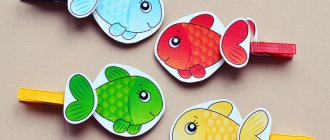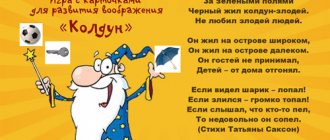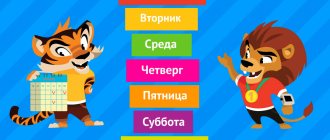Dating games in kindergarten, senior group
- My name - the teacher thinks of an action, for example, jump like a hare. Then he asks: “Who is our Rita?” Upon hearing his name, the child stands up and performs the movement.
- Train - the first child rides like a train. Approaches any child from the group to attach the “carriage” to himself. The signal for the hitch will be the name of the sitting child. The game ends when all the trailers are attached to the locomotive.
- Stand up, everyone - the teacher says, and the guys do: “Stand up, everyone whose name is Pavel,” “Stand up, everyone who has the letter O in their name,” etc.
- Affectionate names - the teacher asks the child to name his neighbor on the right with an affectionate version of the name: Igor - Igorek, Marina - Marishka.
- Caterpillar - children, one after another, depict a caterpillar. The “head” turns to the body and asks: “What is your name?” The first part of the “torso” answers and asks further, turning back. Until the caterpillar finds out what names it consists of, the game does not stop.
Summer camp dating games
- Animals - the player must gesture to show an animal, but with the condition that its name matches the first letter of the child’s name. The guys must guess not only the name of the animal, but also the name of the child.
- Snowball - the first child says his name. The second says the name of the first and his own, the third name of the first, second pupil and adds his own and so on in a circle until the names of all the children are listed.
- My favorite activity is that children are given lists of things to do: I like to snowboard, I break dance, I like to read. There are about ten positions in total. The guys need to write in front of these things the names of the guys who have the same hobbies as those on the list.
To make it easier for children to remember names, associate them with something, combine them with namesakes, play the name game several times. Children themselves may be embarrassed to ask each other’s names, so the task of the teacher and educator is to call children by name loudly and often.
Dating games in kindergarten, junior group
- Whose voice? – the presenter stands with his back to the children sitting in a semicircle. One of the guys must pronounce any word, for example, an object that he sees in the room. The presenter guesses who the voice belongs to.
- Whose things? - The children’s things are put in the box: toys, hairpins, gloves. Then the teacher takes out the item, and the children must name whose it is.
- Find the toy – the toy is hidden in the crib or closet. The teacher prompts: “She is in Katya’s crib,” “The toy is in Lesha’s locker.”
- How to get there - the guys scatter around the group and sit in different places. The second part of the children one by one approaches the teacher and asks: “How to get to Dima? How to get to Polina? The teacher answers: “Take three steps” or “Dima for the flower.”
- Come to us - children are divided into two teams and stand opposite each other at a distance of several meters, holding hands. One team asks the second player, for example, Kolya. He must run between the guys of the opposing team to unclasp their hands. If successful, he takes one of the players to his team, if not, he stands between these players.
Target. Help children adapt to changed conditions in the group, find out the purpose and functions of individual objects, and show their location.
Approximate move e to s chickens s and and. The teacher invites the children to ride the train. Everyone takes their seats on the train (children stand behind the teacher or sit in random order on chairs placed one after another). The teacher announces that boarding the train is over. Everyone sings a song:
Here our train is moving, the wheels are knocking;
And the guys are sitting on our train.
And here's the stop, it's time to get off.
- Get up, guys, let's go wander...
Possible stops: “Knizhnaya” - book corner; “Drawing” - a corner of artistic activity; “Game room” - toys; “Moidodyr” - washroom; “Tired children are sleeping” - bedroom, etc.
At each stop, the teacher and the children find out what objects are in this place (they live at this station); examine individual objects (2-3 objects) in the following sequence: what it is, what kind of object it is (external signs), why children need this object, how to use it, where and how it is stored.
Note. During one lesson you can visit two or three places; visiting the remaining stations and examining objects are postponed to other days. The journey can be diversified with neutral stops where children are given the opportunity to move around (“Plyasovaya”, “Zayushki-na”, “Topotushki”, etc.).
It is advisable to consolidate children’s acquired ideas about specific objects through their corresponding activities. For example, at the Knizhnaya station, children choose a book, the teacher takes it with them and, after returning from the trip, reads the book to the children. After reading, the teacher asks the children where the book lives, where its home is, and invites the children to put the book back in its place. At the “Risovalnaya” station, children take pencils and paper, and after returning, the teacher invites the children to sit down and draw (“Remember, the pencils told us that they really love it when children draw with them”). After drawing, the teacher remembers with the children where the pencils live (in boxes, in cups that stand on the table near the window), etc.
Getting to know the group site (excursion)
Target. Help children adapt to changed conditions on the site, find out the purpose and function of individual items and objects, and show their location.
Approximate course of the excursion. Familiarization with objects in the group area (play equipment) is carried out in the same way as familiarization with objects in the group room.
An obligatory aspect of this excursion is familiarization with the flora represented on the group’s site. The teacher draws the children's attention to the fact that when all the children leave the site, trees, bushes, grass, and flowers remain on it, for which the site is their home. They never leave him; they really want to meet and make friends with children. You can give the names of trees and bushes.
Note. The group's exploration of the site can be continued on other days. The teacher invites the children to carefully look at the group plot and say who else is there (birds, ants, worms, beetles, butterflies, etc.). Encourages children to be attentive to guests, because friendship with them will bring many surprising and interesting meetings for everyone.
Based on a kind of humanized communication with representatives of the animal and plant world, observations of nature are built, ritual greetings are introduced to trees, bushes, sun, rain, snow, wind, birds, a cat running through the area, etc.
For example, children, going for a walk, greet their poplar and choose affectionate words (sweet, beautiful, wonderful, slender, etc.). The teacher tells the children that the poplar is glad to see them today, has been waiting for them and has prepared gifts for them - autumn leaves. Children look at the leaves, play with them and take the most beautiful ones to the group to create a piggy bank “Autumn Gifts”. Over the course of the year, ritual greetings are gradually replenished due to the introduction of artistic words and folklore.
Our group (our site)
Target. Summarize and consolidate the ideas children have received about their group.
Material. Bird (toy or picture).
Approximate course of the lesson. The teacher tells the children that today their friend Sparrow will come to visit them.
The teacher takes out a toy (picture). Children greet the bird, she greets them (names each child).
Sparrow says that he misses the children, looks around and reports that he really likes their group. But things are different for people than for birds. Sparrow asks the children to show him the group and tell him where and what the children have, what they do, why they need certain items.
The teacher and children go around the group, stopping in different places in the room. Children tell what kind of place it is, what objects live there, what they are for, and how to use them. The results of children's activities must be demonstrated. “Look, Sparrow, what wonderful drawings the children drew with these pencils. But these are the books we love to read. Here we also keep your gift - the book by S. Marshak “Where the Sparrow Dined.” This is where the cubes live. Sparrow, would you like the children to build you a path out of blocks?” Children take one cube at a time and put them in a row. A sparrow jumps along a built path.
Next come the game exercises.
Sparrow. When I need to clean my wings, I look for a puddle and swim in it. And you children, where do you wash? What do you wash your face with? What do you wipe with? (Children lead the sparrow to the washroom.)
Sparrow. When I'm tired, I go to bed. I’ll hide under the roof, fluff my feathers, close my eyes and sleep. And you children, where do you sleep? (Children lead the sparrow into the bedroom.) Why do you need all these things (pillow, blanket, sheet)? (Children try to explain the purpose of these objects.)
You can finish the lesson with the active game “Sparrows and the Car.”
The children say goodbye to Sparrow and ask him not to forget them and come visit them.
Note. By analogy with this lesson, work is carried out at a group site.
Outside of class
"Treasuries" of children
At the beginning of the school year, each child brings his own “treasury” to the group. This could be a handbag, backpack, cosmetic bag, etc. “Treasuries” are chosen by the child at home together with his parents. It’s good if parents show creativity and make this “treasury” for their child themselves (sew, embroider, decorate, knit, etc.).
In the “treasury” the child stores the most significant and valuable things for himself. Its contents are an inexhaustible source for observations and conversations with the child throughout the school year.
Children have the right, in their free time, to take their “treasuries” and immerse themselves in their contents. It is at such moments that the teacher should show interest in the child and his activity, sit down with him, and start a conversation. Children readily respond to such communication, since it is based on content that is close and interesting to the child.
Consider where to store children's treasures. This could be a shelf, a cabinet in a group; a child can keep a “treasury” in his closet in the locker room.
Remember!
“Treasuries” are the personal property of the child. Adults do not have the right to touch them without children or throw anything out of them.
Dating games for teens
- Born together - children should find out with whom they have the same or close dates of birth. Then they need to learn as much as possible about each other. At the signal, teenagers take their place and try to give a short story about their new friends.
- Symbol – assign a specific symbol to each teenager. For example, imagine that Olya is an animal. What animal is she associated with? Why? You can associate children with days of the week, products, fruits, months, lessons and so on.
- Guess the name - the presenter asks the participants to say their name so as not to say it directly. Everyone has the right to give two clues about their name, the rest guess. For example, the name is translated “chosen one” - Elena; This was the name of the hero of Pushkin’s novel – Evgeniy; my name is similar to a woman’s jewelry - Sergey (earring).
Summary of the training session “Getting Acquainted”
(For preschoolers 4-5 years old)
Description . This lesson represents the beginning of a cycle of lessons in the developmental program. It can be used in the introductory block of developmental programs, allowing you to orient children to classes in a playful way, accepting work rules and effectively realizing other goals.
The goal is to form a training group of preschoolers aged 4-5 years for the effective subsequent implementation of the developmental program.
Tasks:
- arrange for group members to meet a psychologist;
- organize conditions for the adoption of group practice rules;
- reduce the emotional stress of preschoolers;
- create a favorable psychological atmosphere in the group;
- create a situation of success for preschoolers;
- introduction to the development program.
Equipment: butterfly toy, pictures of butterflies (3-4 pictures), musical accompaniment - P.I. Tchaikovsky “Polka”, music player, toy camera, “general photo” coloring book, colored pencils.
The lesson is aimed at 5-7 preschoolers aged 4-5 years.
Expected result : the initial stage of the formation of a training group of preschoolers with ideas about the rules of behavior in the classroom and a positive attitude towards them.
Progress of the lesson:
1. Greeting . The goal is motivation for activity, initial acquaintance with the rules in the classroom. The form is conversation.
Description: A psychologist comes to the group, gathers children around him and invites them to go with him on a trip to one of his friends. At the same time, he warns that he will take the guys on a trip if they promise to all go together (not run away), speak in turns, walk together (help each other, don’t fight, don’t offend each other) and as soon as they hear three claps, there should be silence . After which he invites everyone to get on the train and go for a visit.
2. Steam locomotive . The goal is to create an emotional mood for the lesson. Form is a game.
Description: the psychologist invites the children to get on a train and hit the road. At the same time, he suggests singing a song along the way: The locomotive is traveling, the locomotive is traveling, it took its friends to visit. Two pipes, a hundred wheels, he took his friends to visit. He brought two pipes and a hundred wheels to visit his friends. Tu-tu-tu… .
3. Meet the butterfly. The goal is to develop self-presentation skills and maintain interest in activities. Form – conversation, exercise.
Description: a psychologist with children drives up on a “steam locomotive” to a toy – a butterfly – lying on the table. The psychologist draws attention to how beautiful his familiar butterfly is and invites the children to sit on the carpet around the toy. “Butterfly” welcomes her guests and tells them that her name is butterfly Zoya and she loves to fly and relax on flowers. He asks what each child’s name is and what he likes to do, and shakes everyone’s hand.
4. Flight of butterflies . The goal is to reduce muscle tension, master the rule of three claps and silence, increase the emotional background, and create conditions for self-expression. Form is an active game.
Description: “butterfly” invites the children to play her favorite game and imagine that they have become butterflies and are flying and dancing beautifully over the field. But as soon as three claps sound, the butterflies should immediately sit on the flowers and silence should fall. The game is played with musical accompaniment - P.I. Tchaikovsky "Polka". The game is played in 3-4 steps.
5. Blitz survey. The goal is to create a situation of success. The form is conversation.
Description: “Butterfly” invites everyone to sit down, praises them for their beautiful dancing and attentiveness. She says that she also has friends, they also like to play and begins to show photographs of her friends (pictures of butterflies). The psychologist asks the children what color this butterfly is, what size, what size, what shape the wings of the butterfly resemble.
6. General photo. The goal is to experience comfort in situations of interaction with peers. The form is joint drawing.
Description: a psychologist asks a butterfly why she was upset. “Butterfly” replies that she has so much fun playing with the guys, they are so friendly and cheerful, and without them she will be sad. The psychologist invites the children to take a photo together with a butterfly as a souvenir using a magic camera, so that she would not be so sad without them. The children stand near the butterfly, the psychologist takes a photograph of them and shows them a coloring drawing of children with a butterfly. And he invites the children to color it so that the photo of the butterfly remains beautiful, and invites them to the table. At the end of the work, the psychologist and the children present the resulting “group photo.”
7. Farewell. The goal is to accept the rules of the lesson and develop reflection. The form is conversation.
Description: “Butterfly” praises the guys that they know so much and how friendly they played with her. He points out that this is because the guys followed the rules: everyone played together (don’t run away), they spoke in turns, helped each other, and after three claps there was silence.. He asks the guys if they remember what they played with the butterfly. Invites them to visit next time, says goodbye to everyone
8. Steam locomotive . The goal is to create an emotional conclusion to the lesson. Form is a game.
Description: the psychologist invites the children to get on a train and hit the road in a group. And sing a song along the way: The locomotive is traveling, traveling, he took his friends to the group. Two pipes, a hundred wheels, he took his friends to the group. He brought two pipes and a hundred wheels to the group. Tu-tu-tu… . In the group, the psychologist says goodbye to the guys
Used sources:
The text of the song by S. Ernesaks, V. Tatarinov “a steam locomotive is traveling, two labors and a hundred wheels.”
Dating games in kindergarten, middle group
- I give a toy - the children stand in a semicircle near the teacher with a bag of toys. Each child takes out a toy in turn and says to whom he will give it: “I give the toy to Alena.”
- Pie – children work together to bake a pie. Children say the child's name, and the teacher gives him a task: sift flour, roll out dough, wash fruit, etc.
- For those who are lost , the children stand in a circle. The teacher asks them to close their eyes and takes one child behind a tree, into a gazebo, or behind him. Then the guys open their eyes and guess who is lost.
- Name the name in motion - you need to add the name movement: running Alina, playing Senya.
- Repeat - the child says his name and shows the movement. The second must repeat both the name and the movement. For example, “I am Lyuda”, curtsies, the second child says: “You are Lyuda” and repeats the curtsey.
Dating games for primary schoolchildren
- Magic brush - use a pen without paste to squeeze out the child’s name on a piece of paper. Then, together with the children, shade the paper with a simple pencil so that the name appears. Ask the guys with that name to stand up.
- Kaleidoscope of names - the teacher names the letters of the alphabet. If a student's name begins with that letter, they must stand up and introduce themselves.
- Parcel - the first participant says: “Clap - the owl’s name - top - the name of the one to whom he passes the baton (parcel).”
- Groups - the teacher invites the children to join groups with classmates with the same names. Those who have a rare name are united in the “Assorted” group.
- Fun tasks - the teacher calls the names of classmates and comes up with tasks for them. For example, Zhenya and Sonya hold hands and jump, Vanya and Lera dance a polka.







